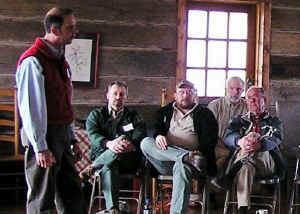Loss
of Hemlocks Threatens BSG Water Supply
Many
Hemlocks Can Be Saved
Big
Stone Gap town councilman Freddie Allison came to Dungannon last
Friday hoping he would hear some good news about saving the giant
hemlock trees at the Big Cherry Reservoir.
He and other leaders from
Virginia
,
Kentucky
,
Tennessee
and
North Carolina
were invited to a conference sponsored by The Clinch Coalition to
hear from experts who have been battling the dreaded hemlock
woolly adelgid.
“We must act fast” says Allison. “I went into the
meeting not knowing for sure that we could save any of our
hemlocks because of the high cost of treating them. Thanks to this
convening, I now know that we can save most, if not all of the
healthiest hemlocks if we work together before the infestation
gets any worse.”
Allison is very concerned about the survival of the hemlocks
around the Big Cherry Reservoir because they are the main tree
species in the four-mile-stretch between the lake and the intake
at the water plant.
“If these hemlocks die, the water quality will be very
much affected,” Allison adds.
“The
cost of treating them now will be much lower than the cost of
cleaning up dead trees or extending our intake up to the lake
itself, which is not a viable option.”

Town
Councilman Freddie Allison seated right listens to Rusty Rhea,
USFS.
The
leading hemlock woolly adelgid
experts in the region presented information about the history of
the invasion of this insect into the eastern
United States
and more recently into the Appalachian mountain forests. They
brought information on what has been done to stop the infestation
in other areas and ideas of what can be done in southwest
Virginia
and surrounding states.
According
to Will Blozan, President of the Eastern Native Tree Society and
co-owner of
Appalachian Arborists
out of
Asheville
,
NC
, “We have the advantage of the hard work of treatment in other
areas. We now know that:
- You
can't save them all
- You
can’t stop the spread
- You
can save individual trees and forests
- Large,
remote tracts can be preserved
- You
have to act quickly and aggressively
- Monitoring
with no action is a death sentence
- Apathy
is a choice; in other words, death
Ron
Bush, of the Clinch Ranger District,
Jefferson
National Forest
told the audience that the insect was first discovered locally in
August 2006 at the Flanagan Reservoir in
Dickenson
County
.
In November of 2006 The Clinch Coalition began exploring and
monitoring hemlock stands on the Clinch Ranger District and has
found the wooly adelgid
at several other locations, including Roaring Branch in
Wise
County
and at Devil’s Fork and Hanging Rock in
Scott
County
.
“At this point” Bush said, “Virginia Tech has released
some beetles on Devil's Fork and will do another release. We
hope to be able to do a chemical treatment by the fall.”
Though beetles are being used in some places, they have not
been found to be very affective. According to conference presenter
Rusty Rhea, Forest Entomologist with the US Forest Service out of
Asheville
,
N.C.
“Soil injection of the chemical Imidacloprid is the most
effective method of killing the insect. The cost has recently come
down dramatically because the patent expired a couple years
ago.”
Jeremy Stout,
Bristol
’s Steele Creek Nature Center Manager, noted that this chemical
is based upon the naturally occurring pesticide nicotine. "Imidacloprid
is the active ingredient in most flea medications," Stout
said, adding that the chemical does not affect animals other than
insects and zooplankton.
Rhea went on to tell the audience that the “ecological
effects of the Hemlock loss will be the most far reaching and
significant. The increase in stream temperature impacts
insects which impacts trout and other aquatic life. There
are also some birds which nest and forage in hemlocks exclusively
and there are no real substitute tree species.”
Public land managers across the region are treating their
hemlocks.
As for private landowners, the experts suggest the
following:
·
If you suspect that your hemlocks are infected with hemlock
woolly adelgid, first look for fuzzy white masses on
the undersides of the needles to determine whether the insects are
present.
·
Landowners can treat infected trees using the soil
drench method, which consists of pouring diluted Imidacloprid onto
the soil. Trees should be treated in spring or fall when the
soil is moist but should not be treated if rain is expected for
the next day.
For
a landowner’s fact sheet on how to identify and treat the adelgid,
visit The Clinch Coalition's website at www.clinchcoalition.net.